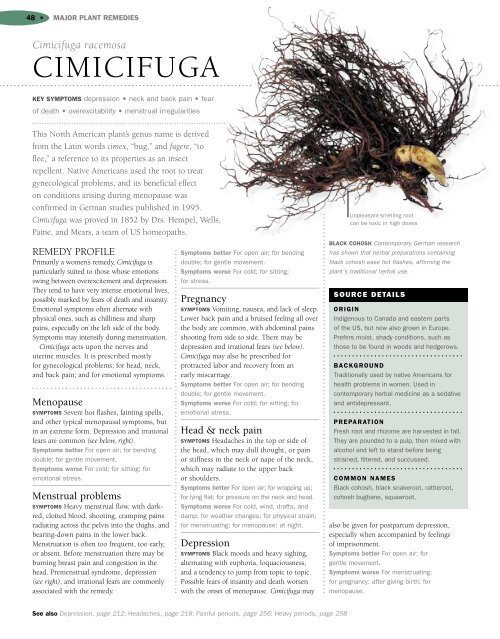Encyclopedia of Homeopathy
Encyclopedia of Homeopathy
Encyclopedia of Homeopathy
You also want an ePaper? Increase the reach of your titles
YUMPU automatically turns print PDFs into web optimized ePapers that Google loves.
48 •MAJOR PLANT REMEDIESCimicifuga racemosaCIMICIFUGAKEY SYMPTOMS depression • neck and back pain • fear<strong>of</strong> death • overexcitability • menstrual irregularitiesThis North American plant’s genus name is derivedfrom the Latin words cimex, “bug,” and fugere, “t<strong>of</strong>lee,” a reference to its properties as an insectrepellent. Native Americans used the root to treatgynecological problems, and its beneficial effecton conditions arising during menopause wasconfirmed in German studies published in 1995.Cimicifuga was proved in 1852 by Drs. Hempel, Wells,Paine, and Mears, a team <strong>of</strong> US homeopaths.REMEDY PROFILEPrimarily a women’s remedy, Cimicifuga isparticularly suited to those whose emotionsswing between overexcitement and depression.They tend to have very intense emotional lives,possibly marked by fears <strong>of</strong> death and insanity.Emotional symptoms <strong>of</strong>ten alternate withphysical ones, such as chilliness and sharppains, especially on the left side <strong>of</strong> the body.Symptoms may intensify during menstruation.Cimicifuga acts upon the nerves anduterine muscles. It is prescribed mostlyfor gynecological problems; for head, neck,and back pain; and for emotional symptoms.MenopauseSYMPTOMS Severe hot flashes, fainting spells,and other typical menopausal symptoms, butin an extreme form. Depression and irrationalfears are common (see below, right).Symptoms better For open air; for bendingdouble; for gentle movement.Symptoms worse For cold; for sitting; foremotional stress.Menstrual problemsSYMPTOMS Heavy menstrual flow, with darkred,clotted blood, shooting, cramping painsradiating across the pelvis into the thighs, andbearing-down pains in the lower back.Menstruation is <strong>of</strong>ten too frequent, too early,or absent. Before menstruation there may beburning breast pain and congestion in thehead. Premenstrual syndrome, depression(see right), and irrational fears are commonlyassociated with the remedy.Symptoms better For open air; for bendingdouble; for gentle movement.Symptoms worse For cold; for sitting;for stress.PregnancySYMPTOMS Vomiting, nausea, and lack <strong>of</strong> sleep.Lower back pain and a bruised feeling all overthe body are common, with abdominal painsshooting from side to side. There may bedepression and irrational fears (see below).Cimicifuga may also be prescribed forprotracted labor and recovery from anearly miscarriage.Symptoms better For open air; for bendingdouble; for gentle movement.Symptoms worse For cold; for sitting; foremotional stress.Head & neck painSYMPTOMS Headaches in the top or side <strong>of</strong>the head, which may dull thought, or painor stiffness in the neck or nape <strong>of</strong> the neck,which may radiate to the upper backor shoulders.Symptoms better For open air; for wrapping up;for lying flat; for pressure on the neck and head.Symptoms worse For cold, wind, drafts, anddamp; for weather changes; for physical strain;for menstruating; for menopause; at night.DepressionSYMPTOMS Black moods and heavy sighing,alternating with euphoria, loquaciousness,and a tendency to jump from topic to topic.Possible fears <strong>of</strong> insanity and death worsenwith the onset <strong>of</strong> menopause. Cimicifuga mayUnpleasant-smelling rootcan be toxic in high dosesBLACK COHOSH Contemporary German researchhas shown that herbal preparations containingblack cohosh ease hot flashes, affirming theplant’s traditional herbal use.SOURCE DETAILSORIGINIndigenous to Canada and eastern parts<strong>of</strong> the US, but now also grown in Europe.Prefers moist, shady conditions, such asthose to be found in woods and hedgerows.BACKGROUNDTraditionally used by native Americans forhealth problems in women. Used incontemporary herbal medicine as a sedativeand antidepressant.PREPARATIONFresh root and rhizome are harvested in fall.They are pounded to a pulp, then mixed withalcohol and left to stand before beingstrained, filtered, and succussed.COMMON NAMESBlack cohosh, black snakeroot, rattleroot,cohosh bugbane, squawroot.also be given for postpartum depression,especially when accompanied by feelings<strong>of</strong> imprisonment.Symptoms better For open air; forgentle movement.Symptoms worse For menstruating;for pregnancy; after giving birth; formenopause.See also Depression, page 212; Headaches, page 218; Painful periods, page 256; Heavy periods, page 258
















